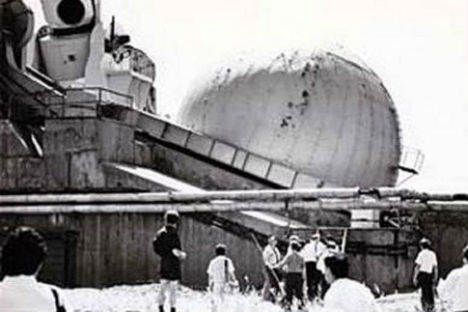
Terra-3. Source: http://topwar.ru/
Advanced before WWII by Einstein, France’s Charles Fabry and Alfred Perot, and German and Soviet physicists Rudolf Ladenburg and Valentin Fabrikant, the idea of the laser captivated academic minds in the 1950s.
Soviet and U.S. scientists soon pulled ahead in laser development, their efforts marked by the award of the Nobel Prize in 1964 to America’s Charles Townes and Russian physicists Nikolai Basov and Alexander Prokhorov.
Pushed on by the military and the escalating tensions between East and West, scientists sought the breakthrough that would add the laser to superpower arsenals.
In the USSR, a group led by Basov proposed using an “optical quantum generator”, or laser, in missile defense systems, using a directed beam to hit ballistic missiles.
Shooting into the sky
In 1966, the Soviets launched the Terra-3 program for the creation of laser ground installations, which was tested in November 1973. Nothing was ever disclosed of the results, but the Defense Ministry in Moscow seemed satisfied enough to order a more powerful unit, which was labeled 5N76.
But the development of such systems was hampered by a constant lack of energy, since the laser had to be powered by a generator with a still unattained capacity.
The 5N76 design languished, but laser experimentation continued up to the 1991 collapse of the Soviet Union. The results of the Terra-3 program are still classified.
A parallel Soviet program of the time was “Omega”. Initially conceived as a laser that would hunt missile warheads, its second strand was to provide a device suitable for air defense.
In 1972, the Sary-Shagan test firing range in Kazakhstan ran trials of the first Omega unit but without the military grade laser, and using a weak transmitter to denote direct hits.
The unit was used to develop targeting systems, and the more powerful Omega-2 gas laser proved capable of hitting aerodynamic targets. But it was also clear that the device lacked destructive power.
A lack of generators, vulnerability to weather fluctuations and the long exposure time required to hit targets combined to obstruct the laser’s development as a combat weapon.
Waging war on satellites
Scientists then looked at using lasers to knock out precision guidance systems. An enemy would not be destroyed but simply left blind by hitting a tank’s optical systems or “frying” military satellite equipment.
From the late 1970s the Soviet Union developed the Skif space combat module, which among other items was to carry a laser weapon capable of disabling enemy satellite electronics.
In 1987 it was decided to test a model of the device together with the new Energia carrier rocket. Due to a technical fault it failed to reach the desired orbit, and although ground controllers still managed to gather some data, the laser-fitted Skif was never built.
While the laser did not make it into space, it found its place in the air. Parallel to a similar program in the United States (the Boeing NKC-135ALL airborne laser laboratory), the Soviets tested their A-60 airborne combat laser under the Falcon Echelon program.
The device was installed on a modified Il-76MD military transport aircraft
Despite appearances, the laser was not in the aircraft’s bulbous nose section, which presumably housed long-distance radar equipment and control systems.
Instead, flanked by two turbo-generators on each side of the fuselage, the weapon was hidden deep inside the aircraft behind sliding panels in the fuselage.
Testing began in 1984, but it is known that this developmental platform was not only used for laser experiments in the atmosphere, as was officially claimed. Test firing took place on stratospheric balloons, ballistic missiles and low-orbit satellites located at altitudes of 30 to 110 km.
Only two A-60 units were built, one of which burned up in 1989 at the airport. The second upgraded version of the flying laboratory only got airborne in 1991 when the days of the Soviet Union were numbered.
The surviving A-60 was laid up for another decade before its time came. In 2002, the U.S. military launched the Boeing YAL-1 airborne laser system which was primarily designed to destroy tactical ballistic missiles.
Back to the drawing board
Russia later decided to revisit its laser experimentation and restarted work on the A-60 and Falcon Echelon in 2005.
While the project remains classified, the head of the Defense Ministry’s armaments department, Anatoly Gulyayev, said in 2011 that “the airborne laser system has been restored.”
Upgrading the A-60 will reportedly include an optical installation with a more powerful laser. And according to the ministry’s television channel, “the actual appearance of combat laser weapons is possible in the period 2015 – 2020.”
Will military lasers remained confined to aircraft, and how will they be used on the battlefield? Read about “laser tanks” in the second instalment next week.
All rights reserved by Rossiyskaya Gazeta.
Subscribe
to our newsletter!
Get the week's best stories straight to your inbox